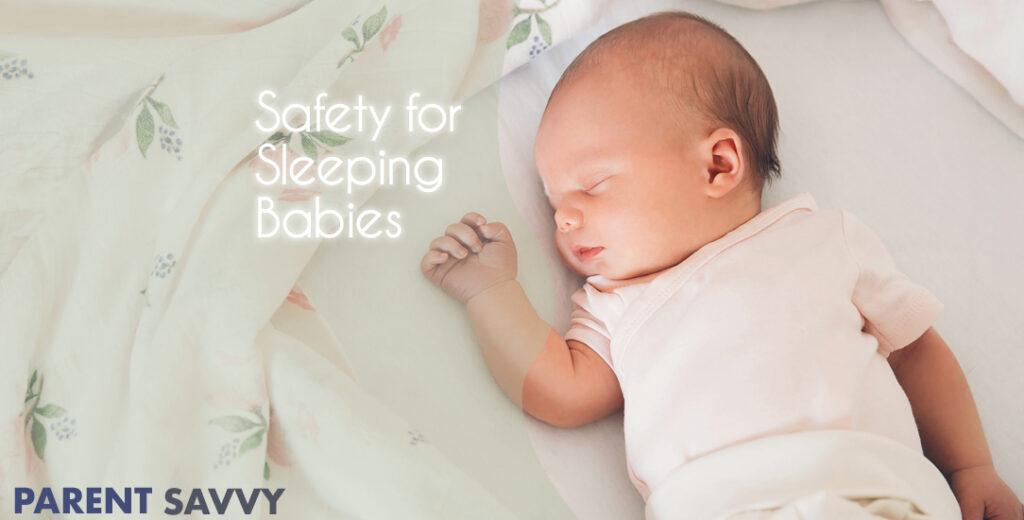
The American Academy of Pediatrics (AAP) regularly releases updated reports based on new evidence for keeping sleeping babies safe.
These reports from the AAP try to reduce the risk of sleep-related infant deaths from SIDS or accidental deaths from suffocation or strangulation. Their recommendations, listed below, help new parents create a safe sleep environment for their babies. These recommendations are for babies up to 1 year of age for keeping sleeping babies safe.
Recommendations for a Safe Baby Bed
- For a baby’s bed, use a firm sleep surface. This can include a crib, bassinet or pack-n-play, all of which should meet the safety standards of the CPSC (Consumer Product Safety Commission). These beds should use a mattress and tight fitted sheet designed for that particular product. A firm surface should not indent when the baby is lying on it.
- Nothing else should be in your baby’s bed other than a fitted sheet and pacifier. Do not keep soft objects, blankets, pillows, bumper pads, stuffed animals, or any other kind of loose bedding in your baby’s crib. Use a wearable blanket rather than loose bedding for warmth.
- Never lay your baby to sleep on a sofa, couch or armchair. This could lead to suffocation.
- Keep your baby’s bed in your room and close to your bed for the first 6 months (ideally for the first year). This may decrease the risk of SIDS by up to 50% and is safer than bed sharing. Room sharing helps you to more closely monitor and care for your baby.
- Do not sleep with your baby in your bed. Sharing your bed can be dangerous if:
- You consumed any alcohol or drugs.
- You are a smoker.
- Your baby is younger than 4 months.
- Your baby was born with a low birth weight or prematurely.
- The mother of the baby smoked during pregnancy.
- There is soft bedding on the bed, such as pillows or blankets.
- The surface of the bed is soft.
- You are not the baby’s parent.
- You may bring your baby to your bed for feeding or comfort, but try not to fall asleep with your baby in your bed. Keep all soft bedding away from your baby to prevent overheating. Return your baby to his bed when you both start to fall back asleep.
- You may swaddle your baby, but if your baby is almost ready to roll over, stop swaddling him for sleep.
- Offer a pacifier at sleep time. Wait until breastfeeding is established before introducing a pacifier. Pacifiers can reduce the risk of SIDS, even if a pacifier falls out of a baby’s mouth after he or she has fallen asleep. Some babies do not like pacifiers, so don’t feel that your baby has to take one.
- Always put your baby to sleep on his or her back for naps and for nighttime sleep. Sometimes parents worry about babies with gastroesophageal reflux sleeping on their backs, but babies will not choke when lying on their backs because their gag reflex and airway anatomy prevents this. Some babies can roll onto their stomach at a young age. If your baby does this, you do not have to return your baby to his or her back. If your baby falls asleep in her car seat, move her to her bed as soon as possible.
Prenatal & Postnatal Recommendations For Keeping Sleeping Babies Safe
Beyond making a safe sleeping environment for your baby, parents can encourage safety and sleep in other ways, as listed below:
- If you can, breastfeed your baby. Breastfed babies have a lower risk of SIDS.
- Go to all well-child visits so your child can receive immunizations. Recent studies show that immunizations may lower the risk of SIDS.
- Let your baby enjoy tummy time every day.
- Do not smoke during pregnancy or after your baby is born and keep your home smoke free.
- Do not use illicit drugs or alcohol during pregnancy or after your baby is born.
Be a Skeptical Consumer
There are many products on the market that advertise an ability to decrease the risk of SIDS. These marketing claims are typically not supported by medical research, so use caution when purchasing products that claim to reduce the risk of SIDS.
If you are unsure about what product to buy, or if you have any questions regarding your baby’s sleep, contact your his or her pediatrician for more information.
